Recent Articles
Popular Makes
Body Types
2024 Ford Mustang Road Test and Review
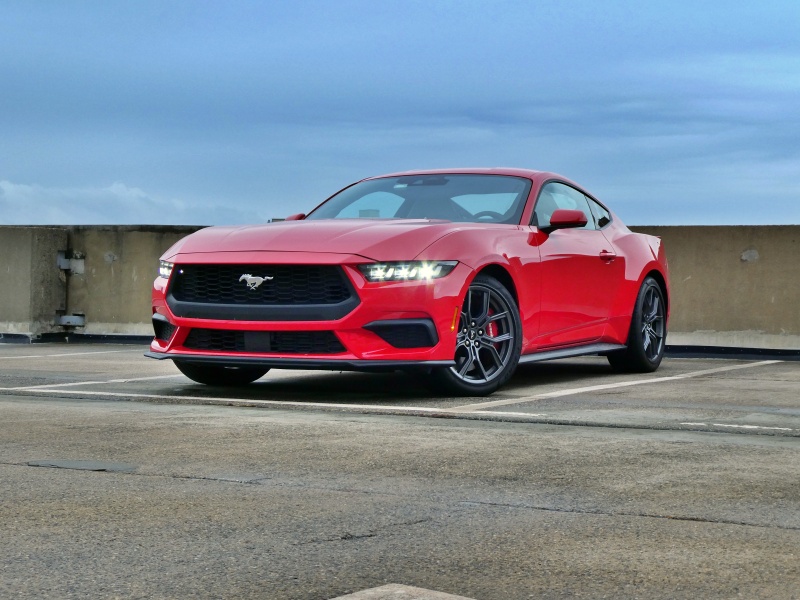
2024 Ford Mustang ・ Photo by Brady Holt
Sixty years ago, the Ford Mustang galloped into the world as an automotive revolution – a hotly desirable blend of style, performance, and value. Four decades later, Ford turned the Mustang from a crude, fast machine into a more sophisticated performance car with retro styling. This year, Ford redesigned it again. This time around, not much has changed.
The redesigned 2024 Mustang, priced from $30,920, looks a lot like last year’s model. And that already looked much like every Mustang going back to 2005. The new Mustang also has much the same mechanical underpinnings as before, without a major overhaul to its engines or platform. And it continues to be sold as a rear-wheel-drive two-door coupe or soft-top convertible, even as its two closest competitors – the Chevrolet Camaro and Dodge Challenger – just ended production. Is this package getting old, or was Ford wise to stick with a familiar Mustang flavor? We just spent a week testing the redesigned Mustang to discover the answer.
Fresh But Familiar Design
Approach the 2024 Ford Mustang like it’s a brand-new car, and it doesn’t look like anything else on the road. It’s a big, wide, low two-door coupe with a long hood and a sleek roofline. In a world where most people buy SUVs, and even most performance cars are everyday hatchbacks and sedans with bigger engines, the Mustang stands apart. Or if you like an open-air experience, it’s also one of nine convertibles (not counting SUVs and trucks) still being made for less than $100,000 – and one of just four that can be had for under $50,000.
However, the new Mustang does still look a lot like the old Mustang. The headlights are now horizontal slits astride the upright black grille, with a simpler shape than before – and not unlike the Mustang’s face from 2015 to 2017. V8 models (though not our four-cylinder test vehicle) now have vertical slots near the sides of the grille. The rear end has a more pronounced crease than before, and the trunk now dips down into the bumper area. And creases along the side are crisper and more defined as well. That about does it for changes. Even if you own one of the first new Mustangs to hit the roads, only Mustang experts will notice.
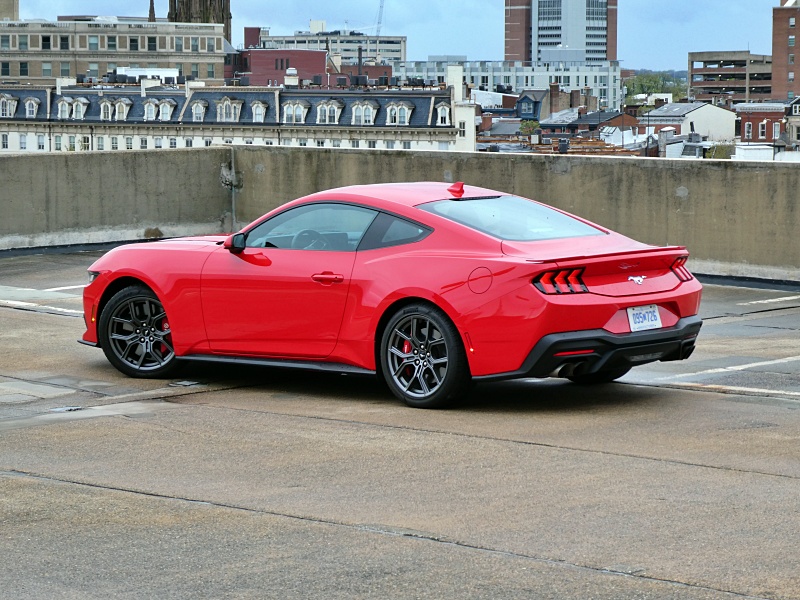
2024 Ford Mustang ・ Photo by Brady Holt
A Fast Base Engine
The Mustang introduced the “EcoBoost” four-cylinder turbo engine back in 2015, and it’s still the base engine today. For 2024, it makes 315 horsepower and 350 lb-ft of torque and comes paired with a 10-speed automatic transmission. So equipped, the Mustang should roar to 60 mph in less than 5.5 seconds – excellent performance for a base model. An optional feature lets you custom-tune the exhaust volume, but even in its quietest mode, it’s neither hushed nor beautiful to listen to. We also found that the car didn’t always accelerate smoothly at low speeds like city traffic. Overall, if you think of the EcoBoost Mustang as any other $31,000 car, it’s a wild performance bargain. But if a glorious soundtrack is part of the experience to you, you’ll want the V8 that we’ll discuss shortly.
Some fans grumbled that the EcoBoost’s output barely budged from last year’s model, but Ford kept the performance lively while improving gas mileage. It now gets an EPA-estimated 22 mpg in the city, 33 mpg on the highway, and 26 mpg combined (or about 2 mpg less with our test vehicle’s Performance Package). That’s 1 mpg better than last year and as economical as a V6 Toyota Camry. We averaged 25 mpg during our weeklong test and hit 32 mpg on the open highway.
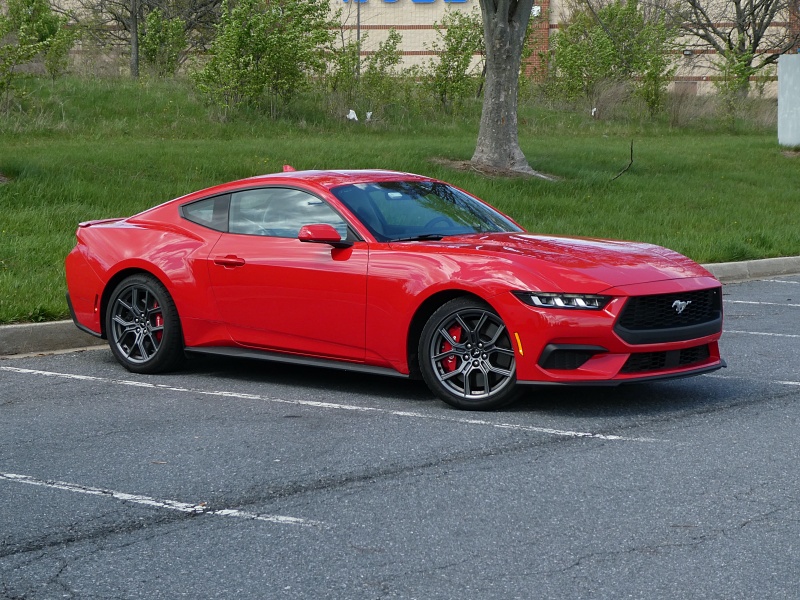
2024 Ford Mustang ・ Photo by Brady Holt
The V8 Option
The enthusiast pick of the lineup remains the 5.0-liter V8. It makes 480 naturally aspirated horsepower and 415 lb-ft of torque on the Mustang GT, while the top Dark Horse model manages 500 hp and 418 lb-ft. And while the four-cylinder has become automatic-only, the V8 still offers a six-speed manual transmission as well.
The V8 delivers a healthy shove of power, but the bigger advantage over the EcoBoost is the noise – for those who like it. With most carmakers picking the efficiency of small-displacement turbos or electric motors, the Mustang is a throaty throwback. An all-electric Mustang Mach E crossover is quicker than a Mustang GT, but without the classic soundtrack. You pay for it at the pump, with an EPA-estimated 16 mpg in the city, 24 mpg on the highway, and 19 mpg combined in the best case (and down to 17 mpg on the Dark Horse). We still miss the Mustang’s 300-horsepower 3.7-liter V6, discontinued back in 2018. It sounded better than the EcoBoost yet was nearly as quick without costing as much as the V8. But that was a niche within a niche. The 2024 Mustang still has two distinct yet appealing flavors of speed.
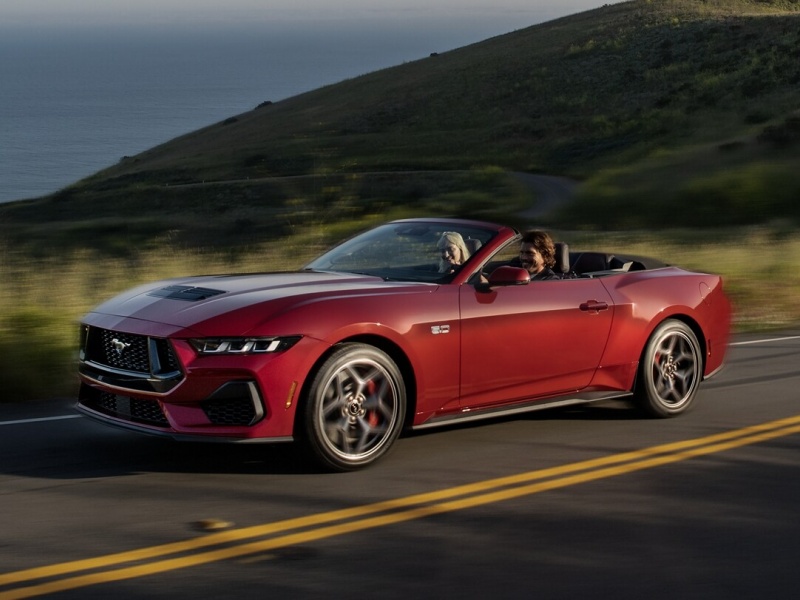
2024 Ford Mustang GT ・ Photo by Ford
Plus High Handling Limits
The Mustang isn’t just about straight-line speed. Ford has built its “pony car” to rival European sports coupes in recent years, and that means it needs to handle, too. This continues into the 2024 Mustang.
A firm yet composed suspension means the Mustang feels firmly planted to the road. Available adjustable dampers let you get a softer ride or tighter body roll at the touch of a button. (The Mustang’s selectable drive modes also adjust the steering and powertrain.) One system even detects potholes and stiffens the suspension so the wheel won’t fall in so far. And the Mustang is also packed with modern driver-assistance technologies, including standard forward and reverse automatic emergency braking and blind-spot monitoring with a rear cross-traffic alert, plus an option for adaptive cruise control and lane-keeping steering assistance. Past all the technology is a familiar issue among modern performance cars: The steering feels numb as you hustle the Mustang. We preferred the sharper, more communicative steering of the recently discontinued Camaro. Still, in a sea of SUVs, that imperfection doesn’t stop us from enjoying any car with a low center of gravity and high handling limits.
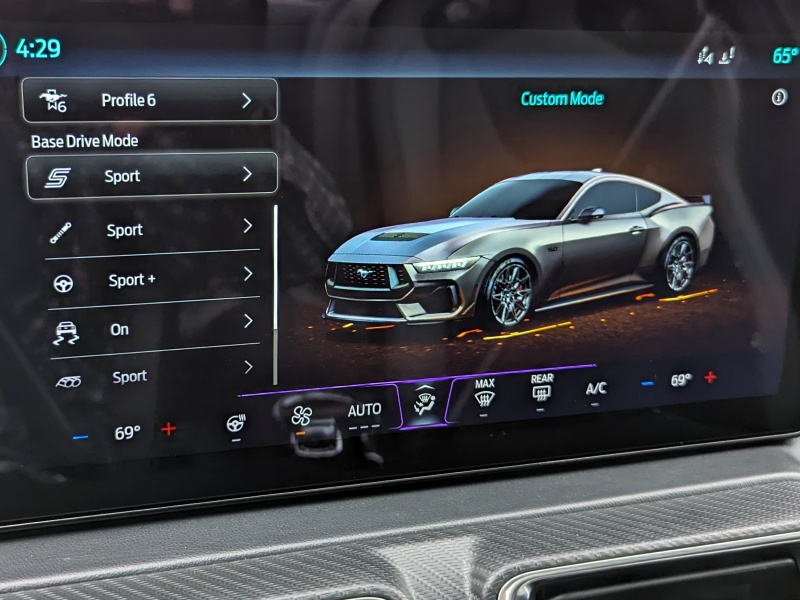
2024 Ford Mustang ・ Photo by Brady Holt
Dashboard Goes Digital
We mentioned how the Mustang’s exterior has changed little in nearly 20 years. That’s not the case for its interior. Ford went with a new digital dashboard that could belong in any affordable performance coupe, with few cues that would make it a Mustang in particular.
Front and center is the available pane of glass that holds a 13.2-inch infotainment touchscreen and a 12.4-inch reconfigurable gauge cluster. This is a design scheme that you’ll find on a growing number of brands from BMW to Hyundai, and it doesn’t accommodate the Mustang’s symmetrically hooded dashboard. We don’t agree with critics who say the screens look out of place in this cabin. Their angularity matches the interior’s overall vibe. The Mustang is a red-blooded performance machine, not a froufrou luxury ride. (Base Mustangs have the screens as separate pieces, which looks more awkward to us.) The drift-friendly hand operation for the modern electronic parking brake also stands out to us. It’s not a beautiful luxury-car interior, and nor is it a traditional Mustang interior. But it’s an appropriate interior for a contemporary affordable sports car.
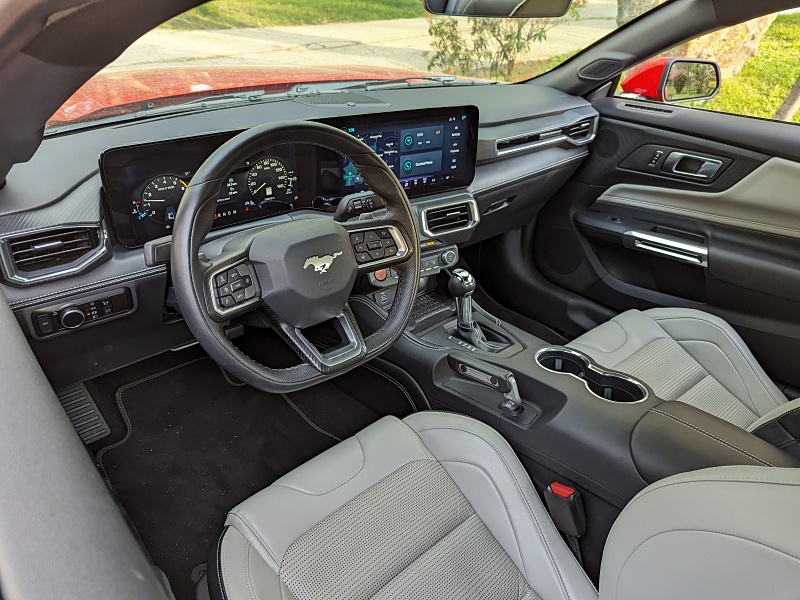
2024 Ford Mustang ・ Photo by Brady Holt
Comfortable for Two
Rather than the Mustang interior’s styling, our complaint about the new layout is the ergonomics. It’s always perilous to put too many controls into a touchscreen, and the Mustang illustrates that. We like how Ford splits the big screen into different sections and lets you swap what you see where. The digital gauge cluster also includes a choice of interesting layouts, including a simple approach that pays homage to Mustangs of the early ’80s. But tapping through menus to adjust climate settings is a chore and a distraction that we’d have rather done without.
Continuing the theme of a sports-car-style interior, the Mustang’s front seats are low to the ground and shaped to hug your body – especially the available Recaro sport seats on our test vehicle. It takes some agility to climb in and out. But the Mustang is a big car. At 75 to 76 inches, depending on the configuration, it’s wider than a Honda Accord family sedan. There’s also ample legroom for the driver and front passenger to stretch out. Note that the Recaro sport seats aren’t available with heating, ventilation, or power adjustability, which felt strange on our $49,000 test vehicle.
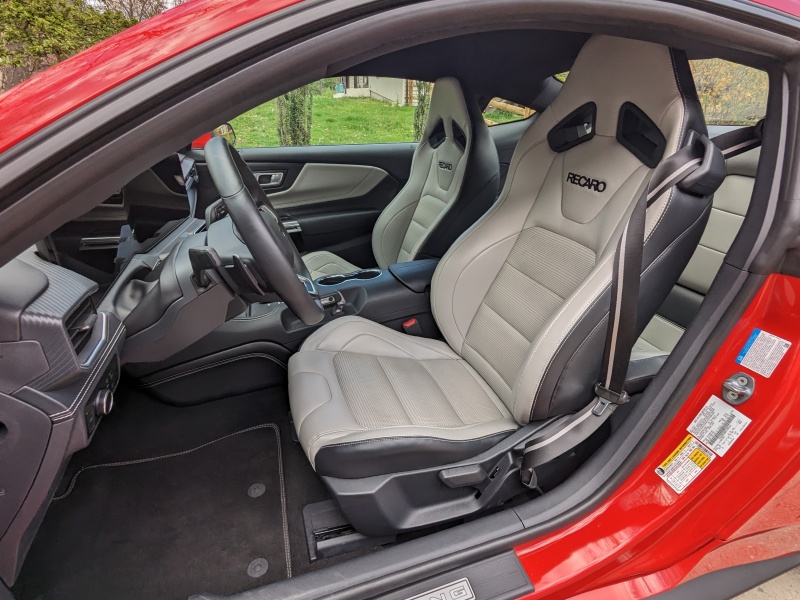
2024 Ford Mustang ・ Photo by Brady Holt
Not a Useful Sports Car
A common trend today is useful sports cars – sedans, hatchbacks, and even SUVs with supersized engines and performance-tuned suspensions. The Mustang doesn’t join the ranks of the Honda Civic Type R, the Audi S4, or the recently discontinued Dodge Challenger in that department. It’s comfortable for two people, and that’s as far as its utility goes.
Sure, unlike a Nissan Z or Toyota Supra, the Mustang has a backseat. That can come in handy in an emergency. But unless the front seats move forward, there’s no rear legroom – literally none. Headroom is also limited. We still pick having a backseat over not having one, but don’t count on it for a road trip with friends. The Mustang’s trunk is decently sized on paper at 13 cubic feet in the Fastback coupe – the same as a Toyota Corolla sedan – and 11 cubic feet in the convertible. But it’s awkwardly shaped and has a small opening. This trunk isn’t bad for a sports coupe – it trounces the barely usable Camaro – but once again, you feel the pinch of the Mustang’s style focus.
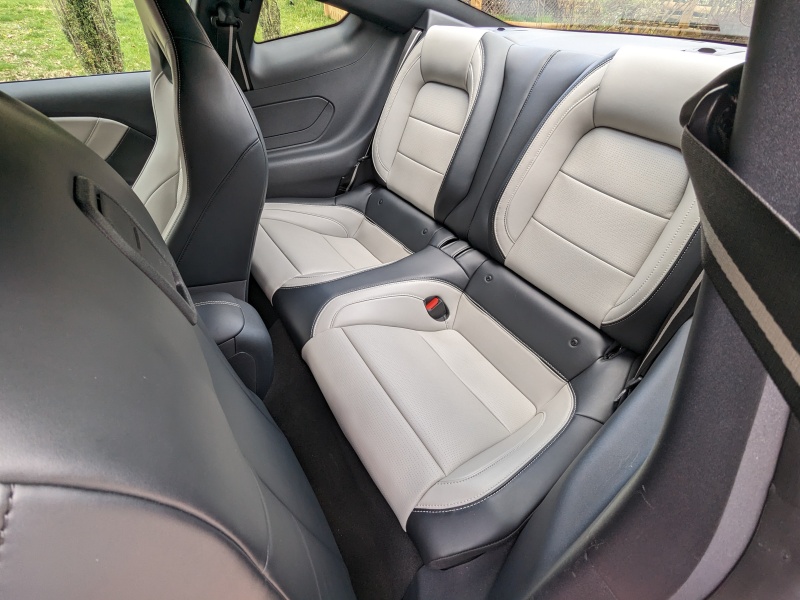
2024 Ford Mustang ・ Photo by Brady Holt
Still a Performance Bargain
As we mentioned, the 2024 Ford Mustang starts at $30,920. That’s not a cheap car, but considering the Mustang’s size and power, it remains a performance bargain. Standard features include 17-inch alloy wheels, automatic climate control, push-button starting, and the driver-assistance features we mentioned earlier. The V8 GT model starts at $42,495 with similar features except for power seats and bigger wheels. And the convertible starts at $39,020 with the four-cylinder or $52,515 with the V8 (typically costing around $5,000 more than a comparably equipped coupe, though this varies by trim level).
You can option up the Mustang with tens of thousands of dollars worth of higher-end luxury and performance features. This has led some critics to complain that the Mustang is too expensive. But we appreciate that Ford creates a variety of Mustangs. If you choose to get your Mustang with heated and ventilated leather seats, a Bang & Olufsen stereo, adaptive cruise control, and an adaptive suspension, that doesn’t mean you can’t get 315 horsepower in the low $30,000s and 480 horsepower in the low $40,000s. That’s a bargain. And if you add those amenities, it’s still less money than a luxury-badged rival with similar performance.
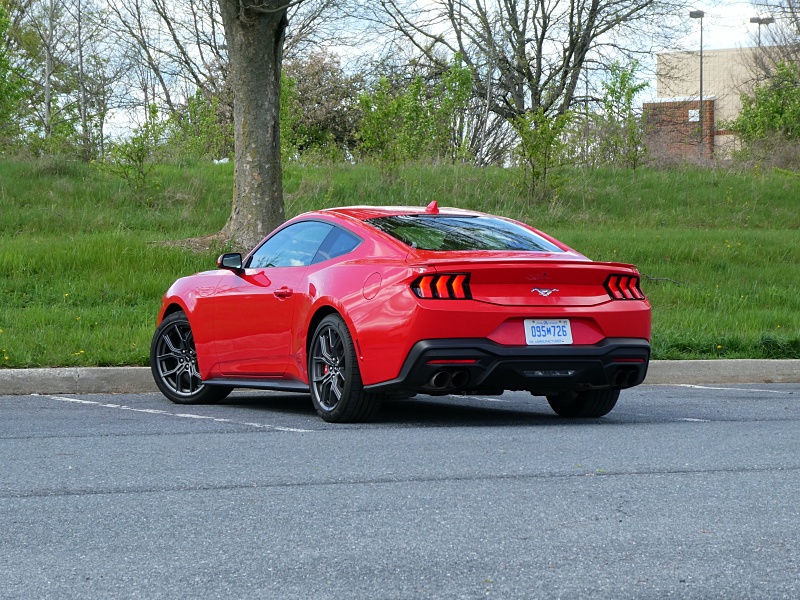
2024 Ford Mustang ・ Photo by Brady Holt
Competitors to Consider
As we write, the last Chevrolet Camaros and Dodge Challengers are still on dealer lots, though both are out of production. The Mustang splits the difference between the crisp-driving but even less spacious Camaro and the big, spacious, and heavy Challenger. But all three deliver reasonable speed even with their base engines, then let you upgrade to incredible V8 power at reasonable prices.
Once that inventory is gone, the Mustang’s rivals become more varied. A Mustang EcoBoost might go against a sensible-shoe-shaped Volkswagen Golf GTI or Golf R hatchback; a smaller, slower Subaru BRZ or Toyota 86 coupe; a two-seat Toyota Supra or Nissan Z; or, if you’d get all the options, an Audi A5 or BMW 430i and 230i luxury coupe. The V8 Mustangs can face the six-cylinder Supra, BMW M440i and M240i, and Audi S5, or even higher-end performance cars like a Porsche 718 or Chevrolet Corvette. One rival will return next year: the 2025 Dodge Charger will now offer a choice of liftback coupe and sedan body styles. And while it will trade its Hemi V8 for a choice of turbocharged six-cylinder engines or an electric motor, it’ll maintain a flavor of affordable speed.
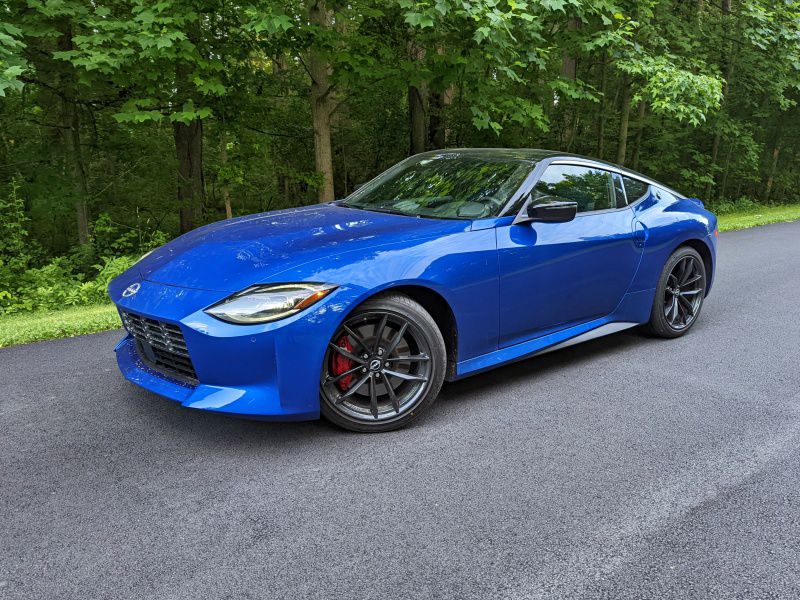
2023 Nissan Z ・ Photo by Brady Holt
Winning by Surviving
The 2024 Ford Mustang is a dinosaur. The point isn't the big screens or the adaptive cruise control. The Mustang is all about style, speed, and loud performance. Any hints at modernization are peripheral, not central, to the Mustang mission.
Competing performance cars have evolved. The Mustang, particularly the V8 version, has stayed true to its fundamentals. If you’re interested in a big, brash sporty coupe, it has won by default. Its muscle for the money remains high, especially if you aren’t picky about features. We might wish for crisper steering and simpler controls, but the simple fact is this: The Mustang flavor has survived. If you like that flavor, Ford gives you the only way to have it – and the new Mustang doesn’t make you feel like you’re missing out.
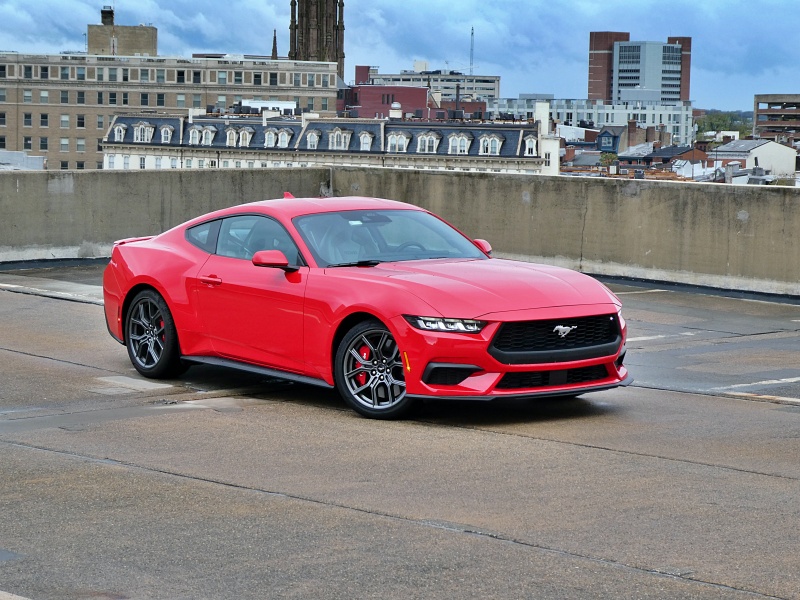
2024 Ford Mustang ・ Photo by Brady Holt